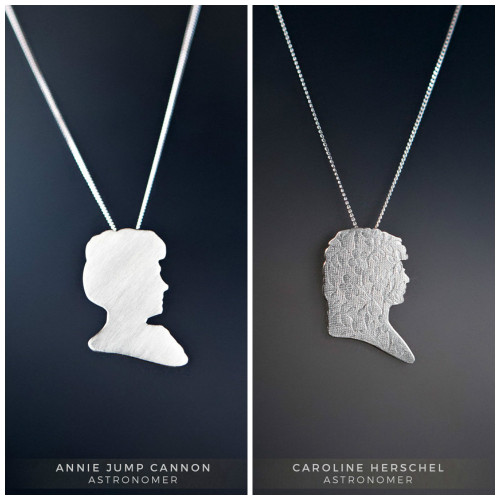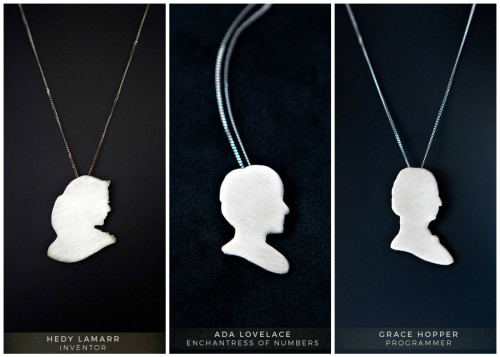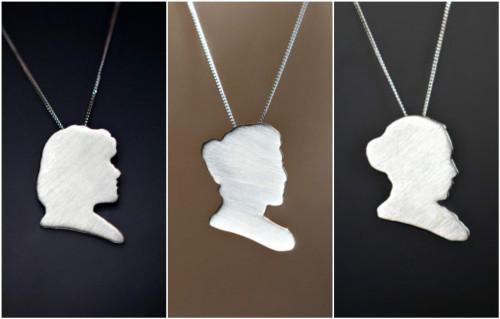As You Can See By These Profiles, A Universal Constant Amongst Science Ladies Is A Need For Hairties.
As you can see by these profiles, a universal constant amongst science ladies is a need for hairties.






What better way to celebrate Women’s History Month than by celebrating these amazing and accomplished women of science, brought to you by Lauren Goldberg (aka Auberg Designs on Etsy).
Each necklace sports the profile (or cameo) of a different woman who pioneered science in her own way. Available in silver, copper, or bronze with different finishes. So many phenomenal women, I can’t choose just one!
Annie Jump Cannon - astronomer
Caroline Herschel - astronomer
Heddy Lamar - inventor/actress
Ada Lovelace - programmer
Grace Hopper - programmer
Jane Goodall - primatologist
Marie Curie - chemist/physicist
Hypatia of Alexandria - mathematician
Sophie Germain - mathematician
Sally Ride - astronaut
Maud Menten - chemist
Lisa Meitner - physicist
BONUS: In honor of Women’s History Month, they are all on sale through the end of March.
- Summer
More Posts from Secretagentpeptidebond and Others
@sheck on Instagram. 💫🌱

The cellular structure of wood as seen through a Victorian microscope. (via)

A Disturbance In The F-Ring
A bright disruption in Saturn’s narrow F ring suggests it may have been disturbed recently. This feature was mostly likely not caused by Pandora (50 miles or 81 kilometers across) which lurks nearby, at lower right. More likely, it was created by the interaction of a small object embedded in the ring itself and material in the core of the ring. Scientists sometimes refer to these features as “jets.”
Because these bodies are small and embedded in the F ring itself, they are difficult to spot at the resolution available to NASA’s Cassini spacecraft. Instead, their handiwork reveals their presence, and scientists use the Cassini spacecraft to study these stealthy sculptors of the F ring.
This view looks toward the sunlit side of the rings from about 15 above the ring plane. The image was taken in visible light with the Cassini spacecraft narrow-angle camera on April 8, 2016.
The view was acquired at a distance of approximately 1.4 million miles (2.2 million kilometers) from Saturn and at a Sun-Saturn-spacecraft, or phase, angle of 105 degrees. Image scale is 8 miles (13 kilometers) per pixel.
The Cassini mission is a cooperative project of NASA, ESA (the European Space Agency) and the Italian Space Agency. The Jet Propulsion Laboratory, a division of the California Institute of Technology in Pasadena, manages the mission for NASA’s Science Mission Directorate, Washington. The Cassini orbiter and its two onboard cameras were designed, developed and assembled at JPL. The imaging operations center is based at the Space Science Institute in Boulder, Colorado. -NASA/JPL-
Image above © NASA/JPL-Caltech/Space Science Institute
Day in the life of a scientist
Me, at an art store: I need a paint marker with low toxicity and a delicate tip.
Employee: What kind of project are you working on?
Me: It's for a research project. I just need bright colors.
Employee: What medium are you using? Canvas or paper?
Me: uh....spiders.
Employee: Plastic or felt?
Me: ....live spiders. Like, from the forest.
Employee: ....
Employee: I have to get back to the counter.

I always get stupid names for these so I have devised an egalitarian solution
-
 a-feminist-dead-poet liked this · 3 years ago
a-feminist-dead-poet liked this · 3 years ago -
 redcoatchemist liked this · 6 years ago
redcoatchemist liked this · 6 years ago -
 totalbratofficial liked this · 7 years ago
totalbratofficial liked this · 7 years ago -
 brandyllyn reblogged this · 8 years ago
brandyllyn reblogged this · 8 years ago -
 lehorlabitch-blog liked this · 8 years ago
lehorlabitch-blog liked this · 8 years ago -
 omg-bookworm reblogged this · 8 years ago
omg-bookworm reblogged this · 8 years ago -
 omg-bookworm liked this · 8 years ago
omg-bookworm liked this · 8 years ago -
 lunaaaalo reblogged this · 8 years ago
lunaaaalo reblogged this · 8 years ago -
 lunaaaalo liked this · 8 years ago
lunaaaalo liked this · 8 years ago -
 rubygeeksout liked this · 8 years ago
rubygeeksout liked this · 8 years ago -
 aubergdesigns reblogged this · 8 years ago
aubergdesigns reblogged this · 8 years ago -
 bekstek liked this · 8 years ago
bekstek liked this · 8 years ago -
 aubergdesigns reblogged this · 8 years ago
aubergdesigns reblogged this · 8 years ago -
 stairwell-flowers reblogged this · 8 years ago
stairwell-flowers reblogged this · 8 years ago -
 stairwell-flowers liked this · 8 years ago
stairwell-flowers liked this · 8 years ago -
 loveinferiorfe-blog liked this · 8 years ago
loveinferiorfe-blog liked this · 8 years ago -
 supercilioushotairballoon reblogged this · 8 years ago
supercilioushotairballoon reblogged this · 8 years ago -
 lee-the-mangrove liked this · 8 years ago
lee-the-mangrove liked this · 8 years ago -
 larkspurious reblogged this · 8 years ago
larkspurious reblogged this · 8 years ago -
 hoziersdiningtable reblogged this · 8 years ago
hoziersdiningtable reblogged this · 8 years ago -
 mouthfulofbirds liked this · 8 years ago
mouthfulofbirds liked this · 8 years ago -
 the-heathen-child liked this · 9 years ago
the-heathen-child liked this · 9 years ago -
 madrigalx3-blog liked this · 9 years ago
madrigalx3-blog liked this · 9 years ago -
 letmebemyown reblogged this · 9 years ago
letmebemyown reblogged this · 9 years ago -
 draculas-bff liked this · 9 years ago
draculas-bff liked this · 9 years ago -
 mixedupchuck reblogged this · 9 years ago
mixedupchuck reblogged this · 9 years ago -
 theforumcat reblogged this · 9 years ago
theforumcat reblogged this · 9 years ago -
 silicasurf-art liked this · 9 years ago
silicasurf-art liked this · 9 years ago -
 theforumcat reblogged this · 9 years ago
theforumcat reblogged this · 9 years ago -
 heartbeattcity liked this · 9 years ago
heartbeattcity liked this · 9 years ago -
 superjrad reblogged this · 9 years ago
superjrad reblogged this · 9 years ago -
 pirripipi-blog reblogged this · 9 years ago
pirripipi-blog reblogged this · 9 years ago -
 thedoubtingelms liked this · 9 years ago
thedoubtingelms liked this · 9 years ago -
 grumpyspacedoctor reblogged this · 9 years ago
grumpyspacedoctor reblogged this · 9 years ago -
 broodytinygaycarmilla liked this · 9 years ago
broodytinygaycarmilla liked this · 9 years ago -
 palirt-blog reblogged this · 9 years ago
palirt-blog reblogged this · 9 years ago -
 palirt-blog liked this · 9 years ago
palirt-blog liked this · 9 years ago -
 whataboutateakettle liked this · 9 years ago
whataboutateakettle liked this · 9 years ago -
 taintedmarker reblogged this · 9 years ago
taintedmarker reblogged this · 9 years ago -
 mrooncat reblogged this · 9 years ago
mrooncat reblogged this · 9 years ago -
 mrooncat liked this · 9 years ago
mrooncat liked this · 9 years ago -
 whileconfettifalls liked this · 9 years ago
whileconfettifalls liked this · 9 years ago









